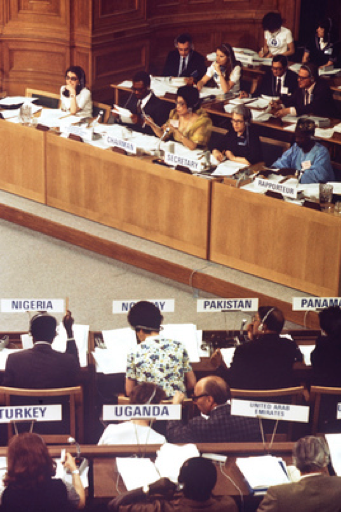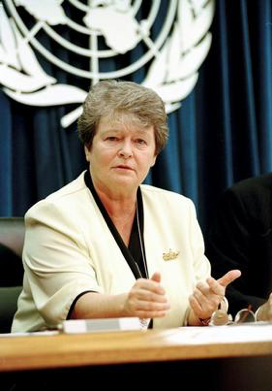The Scandinavian states and the environment in international politics, 1970-2000
The three Scandinavian states of Denmark, Norway, and Sweden all played an important role in shaping international environmental policy from 1970 to 2000, and they have all been key norm entrepreneurs in a variety of International Organizations. Following the growth of the environmentalist movement in the 1960s, Sweden had a pivotal role in the launch of the United Nation’s Conference on the Human Environment in Stockholm and all three states took on the issue of acid rain in the 1970s. The countries’ diplomacy and expertise in environmental issues throughout 1980s and 90s included Norway’s high-profile position within the World Commission on Environment and Development, and their early efforts to fight climate change and, with respect to Denmark and Sweden, to shape the environmental policies of the European Union.

Acid Rain and the Stockholm Conference
A growing domestic concern for the Scandinavian states in the 1960s was the perception of increasing threats to the environment. It is widely acknowledged that it was in that decade that the actual notion of environmentalism as an ideology became prominent. The emergence of modern environment groups was accompanied, in the late 1960s and early 1970s, by the development of the Scandinavian states’ own environmental policies. Their most pressing environmental concern was the pollution of lakes in Norway and Sweden, which was being caused by acid rain. Acid rain was air pollution that was drifting mainly from the industrial heartlands of the United Kingdom and West Germany. In 1967, Sweden demanded that an international response through the United Nations system was needed.
In 1968, the United Nations General Assembly (UNGA) accepted Sweden’s argument for the need for an international conference on the environment and passed UN Resolution 2398, eventually leading to the UN Conference on the Human Environment in Stockholm in 1972. Considered crucial to Sweden’s success was the entrepreneurship of its Permanent Representative to the United Nations, Sverker Åström, who lobbied within the UN system.
Sweden’s Social Democratic Prime Minister Olof Palme argued during a speech at the Plenary Meeting of the Stockholm Conference in 1972 that there were no persons or states when it came to environmental issues and declared that for humankind "Our future is common".
“Our future is common”
The Scandinavian states were also the first to put into practice the most important recommendation of the conference. The declaration following the conference consisted of 26 principles, perhaps the most important of which, Principle 21, states that while countries have the right to exploit their own natural resources, they also have the “responsibility to ensure that activities within their jurisdiction or control do not cause damage to the environment of other States or of areas beyond the limits of national jurisdiction”. Subsequently, the 1974 Nordic Convention on the Protection of the Environment allowed for an individual who had suffered as a result of cross-border pollution to bring legal proceedings against the guilty party, even if that person resided in a different Nordic state. This was the first interstate environmental agreement of its kind (See Hurrell & Kingsbury, 1992, for more information).

PHOTO:A view of the First Committee (Educational Aspects of Environment Issues and Human Settlement Management) as it met on 8 June. At this meeting the Committee approved a recommendation on environment areas, under an international programme relating to the planning and management of human settlements. UN Photo/Yutaka Nagata
In 1970, the Organization of Economic Cooperation and Development (OECD) created its Environment Committee and, in 1974, its first high-level meeting of environment ministers was chaired by the Norwegian Environment Minister, Gro Harlem Brundtland (click here for Brundtland's biography on nordics.info). Throughout the 1970s, the Scandinavian states were diplomatically proactive in raising the profile of the acid rain problem and helped to turn it into a pressing international environmental issue (O’Neil, 2011, p. 84). The actions of the three states were crucial to the formation of the 1979 Geneva Convention on Long-range Transboundary Air Pollution (CLRTAP).
Nevertheless, the Scandinavian states were forced into a compromise by the large industrial pollutant states. Brenton in his 1994 book on the development of environmentalism takes the view that it took until the mid-1980s for this convention to have a noticeable effect. By then it had been proved that 5000 lakes in Norway, as well as 2500 lakes in Sweden, had been affected by acid rain (See the 1985 paper by Brady & Selle, for example). Norway and Sweden continued to argue the case on the effects of air pollution bilaterally into the 1980s. This included lobbying countries like the United Kingdom, which were still refusing to accept responsibility for the issue as set out, for instance, in the autobiography of Gro Brundtland.
The Brundtland Commission and Sustainable Development
The World Commission on Environment and Development (WECD) was formed in December 1983 following the UN General Assembly’s Resolution 38/161. It came to be known as the Brundtland Commission after its chair, Gro Harlem Brundtland, who at the time was also serving as Norway’s prime minister. The Brundtland Commission was a highpoint in Scandinavian influence over international environmental policy. All three Scandinavian states made financial contributions to the running of the Commission. Brundtland, while chairing the Commission, was able to raise Norway’s profile in international environmental issues and the Norwegian Ministry of Foreign Affairs attempted to utilise her position to advance Norway’s foreign policy; because in every country she visited in her role as head of the WECD, Brundtland was also representing Norway. In 1988, after the WECD’s report Our Common Future was released, Norway promptly held a meeting of the OECD to discuss its findings. The most important concept to come out of the report was sustainable development. A new term at the time, sustainable development was coined to refer to the fact that economic development needs to be in line with prevailing environmental conditions and that despite human needs being an essential right, no environmental degradation should occur as a result of this.

PICTURE: Dr. Gro Harlem Brundtland, Director-General of the World Health Organization (WHO). UN Photo/Greg Kinch
Gro Harlem Brundtland, arguably, acted as a staunch proponent for the WECD’s recommendations. In 1988, Brundtland, in conjunction with the UN Secretary-General Javier Perez de Cuellar, hosted the heads of all the UN agencies at a meeting to discuss how to implement Sustainable Development. In 1990, Norway also hosted a conference called “Action for a Common Future”. It was an attempt to refine the concept of Sustainable Development ahead of the United Nations Conference on Environment and Development to be held in Rio in 1992. All three Scandinavian states refined their development aid policies in the wake of the WECD’s report. Denmark produced its own action plan; Sweden merged environmental concerns into its development aid policies; while Norway launched the Norwegian campaign for Environment and Development.
Climate Change and the European Union
The three Scandinavian states have been expressing concern over the issue of climate change since at least the late 1980s. In the fight against climate change, Denmark’s Environment Minister was seen as crucial in the setting up of the United Nations’ Framework Convention on Climate Change (UNFCCC) at the Rio Conference in 1992. In 1989, Norway was the first nation to set emission reduction targets and in the early 1990s, was determined to be a frontrunner in the tackling of climate change. However, Norway tried to offset their own domestic CO2 emission targets against reductions achieved through its overseas development aid programmes; thus, passing the burden of taking on climate change onto developing countries.
In the European Union, Denmark and Sweden have both played prominent roles in promoting new environmental legislation. When the two nations have led EU presidencies, environmental issues have always been a priority and Denmark has often been labelled as the “European Union’s greenest state” (as Tunkrova has described in an 2008 article about Nordic exceptionalism, p. 22). Key actions that Denmark has taken are, for example:
- In the 1980s, Denmark won the right to have higher environmental standards than the rest of the European Economic Community. (See Magnúsdóttir & Þórhallsson’s ‘The Nordic States and Agenda-Setting in the European Union: How Do Small States Score?’ in Icelandic Review of Politics & Administration from 2011 for more on this).
- Denmark demanded that the European Single Market should include an environmental chapter.
- In 1993, the Danish government used its presidency of the EU to support the total ban of toxic waste exports to the Global South by the OECD.
- In 1994, Denmark successfully got a new EU law enacted that banned the export of hazardous waste to the developing world by undermining the position of the EU with the support of the Group 77 (G77), the Global South states, as well as Greenpeace. This occurred at the Second Meeting of the Conference of the Parties to the Basel Convention (COP-II), which was formed in 1989, and was an attempt to regulate the transfer of toxic waste from the North to the developing world.
Some commentators indicate that it is widely acknowledged that Sweden, after joining the EU in 1995, promptly used its international reputation in international environmental affairs to expeditiously gain influence over the EU’s environment policy. At the time, Sweden was renowned for its expertise and national legislation in the area. Swedish officials had built up much more experience in issues around the environment than many other EU member states (See Kronsell's 2002 paper for more on this). Sweden, according to Aynsley Kellow and Anthony R. Zito, “sought to steer EU regulation by building up precedents in other international fora” (2002, p. 56). This means that by promoting their favoured policies in non-legally binding International Organizations like the OECD, it made it easier for Sweden to build up support for these policies in those that were legally binding like the EU.
Finally, according to British diplomat Tony Brenton, the Scandinavian states’ successful negotiating tactics on global environmental policies included setting international environmental targets so high that, when it came to negotiations, their larger opponents would feel themselves pressured by their own individual domestic audiences into making concessions.
Further Reading
- Annika Kronsell, ‘Can Small States Influence EU Norms?: Insights from Sweden's participation in the field of environmental politics’. Scandinavian Studies, 74, 3 (2002), pp. 287-304.
- Aynsley Kellow and Anthony R. Zito, ‘Steering through Complexity: EU Environmental Regulation in the International Context’. Political Studies, 50 (2002), pp. 43-60.
- Benedict Kingsbury & Andrew Hurrell (Eds.). The International Politics of the Environment. (New York: Oxford University Press, 1992).
- Iris Borowy, 'Defining Sustainable Development for Our Common Future: A History of the World Commission on Environment and Development' (Brundtland Commission) (Abingdon: Routledge, 2013).
- Gordon L. Brady and Joseph C. Selle, ‘Acid rain: the international response’. International Journal of Environmental Studies, 24, 3-4 (1985), pp. 217-230.
- Lucie Tunkrova, ‘The Nordic Countries’ `Exceptionalism’ in EU Environmental Policy’. Contemporary European Studies, 2, 21-45 (2008), pp. 21-45.
- T. Brenton, The Greening of Machiavelli: The Evolution of International Environmental Policies. (London: Royal Institute of International Affairs; 2014).